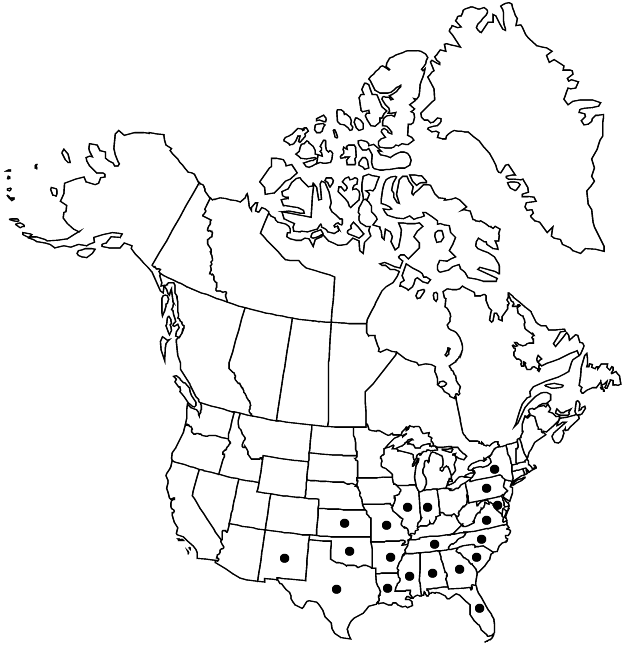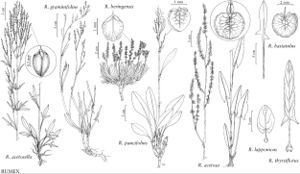Difference between revisions of "Rumex hastatulus"
in S. Elliott, Sketch Bot. S. Carolina 1: 416. 1817.
FNA>Volume Importer |
FNA>Volume Importer |
||
| Line 12: | Line 12: | ||
|name=Acetosa hastatula | |name=Acetosa hastatula | ||
|authority=(Baldwin) Á. Löve | |authority=(Baldwin) Á. Löve | ||
| + | |rank=species | ||
}} {{Treatment/ID/Synonym | }} {{Treatment/ID/Synonym | ||
|name=Rumex engelmannii | |name=Rumex engelmannii | ||
|authority=Meisner | |authority=Meisner | ||
| + | |rank=species | ||
}} | }} | ||
|hierarchy=Polygonaceae;Polygonaceae subfam. Polygonoideae;Rumex;Rumex subg. Acetosa;Rumex hastatulus | |hierarchy=Polygonaceae;Polygonaceae subfam. Polygonoideae;Rumex;Rumex subg. Acetosa;Rumex hastatulus | ||
| Line 39: | Line 41: | ||
-->{{#Taxon: | -->{{#Taxon: | ||
name=Rumex hastatulus | name=Rumex hastatulus | ||
| − | |||
|authority=Baldwin in S. Elliott | |authority=Baldwin in S. Elliott | ||
|rank=species | |rank=species | ||
| Line 54: | Line 55: | ||
|publication year=1817 | |publication year=1817 | ||
|special status= | |special status= | ||
| − | |source xml=https://jpend@bitbucket.org/aafc-mbb/fna-data-curation.git/src/ | + | |source xml=https://jpend@bitbucket.org/aafc-mbb/fna-data-curation.git/src/f50eec43f223ca0e34566be0b046453a0960e173/coarse_grained_fna_xml/V5/V5_1028.xml |
|subfamily=Polygonaceae subfam. Polygonoideae | |subfamily=Polygonaceae subfam. Polygonoideae | ||
|genus=Rumex | |genus=Rumex | ||
Revision as of 21:49, 16 December 2019
Plants annual or short-lived perennial, glabrous, with vertical rootstock. Stems solitary or several from base, erect or ascending, branched in distal 2/3 (in inflorescence), 10–40(–45) cm. Leaves: blade obovate-oblong, ovate-lanceolate, oblong-lanceolate, or lanceolate; 2–6(–10) × 0.5–2 cm, base hastate (with spreading lobes), auriculate, or occasionally without evident lobes, margins entire, flat, apex obtuse or subacute. Inflorescences terminal, occupying distal 2/3 of stem, usually lax and interrupted, narrowly paniculate. Pedicels articulated in proximal part, filiform, 1.5–2.5(–3) mm, articulation indistinct or slightly swollen. Flowers 3–6(–8) in whorls; inner tepals orbiculate or broadly ovate, 2.5–3.2 × 2.7–3.2 mm, base broadly cordate or rounded, apex obtuse or subacute; tubercles absent or some inner tepals with slightly swollen central veins. Achenes brown or dark brown, 0.9–1.2 × 0.6–0.8 mm. 2n = 8 (pistillate plants), 9 (staminate plants), 10 (both sexes).
Phenology: Flowering spring–summer.
Habitat: Dry to moist alluvial and ruderal habitats, river valleys, sandy plains, meadows, waste places
Elevation: 0-500 m
Distribution

Ala., Ark., Fla., Ga., Ill., Ind., Kans., La., Md., Miss., Mo., N.Y., N.C., Okla., Pa., S.C., Tenn., Tex., Va.
Discussion
Rumex hastatulus is distinct in subg. Acetosa and belongs to the monotypic subsect. Americanae Á. Löve & N. Sarkar. It is represented by at least two chromosome races: populations occurring from North Carolina to Florida and Mississippi normally have 2n = 8 in pistillate plants and 2n = 9 in staminate plants; populations from Louisiana to Texas and Oklahoma predominantly have 2n = 10 in both sexes. Rumex hastatulus has been reported from New Mexico (W. C. Martin and C. R. Hutchins 1980, vol. 1), but those records need confirmation. When fruiting, R. hastatulus has large inner tepals that distinguish it from R. acetosella, with which it is occasionally confused.
Selected References
None.
